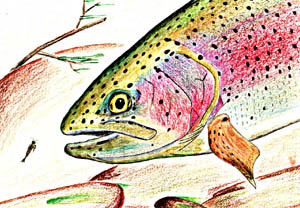Whirling disease:
We don't have it,
we don't want it,
and we need a little help from our friends!
by Clive Schaupmeyer
We don't have whirling disease in Canada, and we want to make sure it stays that way.
But here's what scares the daylights out of me: I could fish in southern Montana in the morning, and (with waders still wet and muddy with Montana river goo) wade into my beloved Crowsnest River in southern Alberta for the
evening rise. If I had been fishing in a Montana stream infested with whirling disease I would almost certainly infect the Crowsnest with this dreaded pest carried in the mud on my waders! If I had been fishing in a Montana stream infested with whirling disease I would almost certainly infect the Crowsnest with this dreaded pest carried in the mud on my waders!
It's that simple folks!
If you have been fishing in an area where whirling disease is present and later plan on fishing "clean" waters (no matter where), thoroughly clean your gear as described below. You'll be doing yourself a favor by helping to preserv
e the future of trout fishing in great waters everywhere.
Whirling disease is caused by a microscopic organism, Myxobolus cerebralis, that affects particularly rainbow and cutthroat trout - and other salmonids as well. Brown trout appear to be immune to the disease but are report
ed to be carriers.
The parasite attacks cartilage in the skull, gill arches and the spinal column of small fish-of-the-year and results in erratic whirling or circular swimming motions. Infected fish can also be deformed and have black tails. The fis
h are unable to swim after food and are vulnerable to predation by birds. Severely infected fish die and populations of rainbow and cutthroat trout have crashed in heavily infested waters. Did I mention we don't want this disease up here?
The micro-organism spends part of it's life cycle in small tubifex, mud-dwelling worms. These parasitized worms can survive a road trip in mud on the bottom of waders, fins, float tubes or boats and can later release the parasite i
nto previously non-contaminated water.
If you have been fishing in waters where whirling disease is present you must thoroughly clean and disinfect all wading gear before leaving the general area and heading for unaffected waters. According to information (gathered on t
he internet) states that have at least some infected waters include Colorado, Montana, Utah, California, Idaho, Nevada and Oregon. Sure we want to keep whirling disease out of Alberta and other Canadian provinces, but these precautions apply to all in
fected and uninfected waters. There are still many streams and lakes in the states mentioned that are free of the disease. And many other states that have trout waters are also free. Always use the same precautions when traveling and fishing from pla
ce to place within one state, between states, or between Canada and the United States.
Use a high-pressure hose to clean mud from boats, trailers, waders, boots, float tubes and fins. Then rinse the gear with a 1:5 solution of household bleach and water. Rinse and air dry the equipment out of the sun. (The combinatio
n of sunlight and bleach can weaken fabric.) If you are worried about the effects of bleach then use another set of gear and leave your contaminated gear at home.
Felt soles are a haven for the parasite and MUST be treated with bleach to ensure total destruction of this pest. Dr. Karl M. Johnson, of the Whirling Disease Foundation, recently reported that each square inch of felt wading sole
can retain between 1,200 to 4,800 spores of the parasite! The felt MUST be soaked for at least ten minutes to ensure that the parasite-killing bleach gets to all parts of the thick felt. If you don't want to treat your felt-soled wading boots with bleach
then buy another pair of boots before heading elsewhere or stay home. L.L. Bean is advertising a new Aqua Stealth wading sole that is completely washable and that will not harbor this pest provided they are washed in uncontaminated water.
It is also important to clean last month's or last years's mud from all of your trout-fishing gear when traveling to new waters. According to various sources spores of the parasite remain viable for 20 or 30 years under the right c
onditions. The parasite can withstand freezing and desiccation. And, so far, there is no magic "silver bullet" that will control this destructive pest. So not only is it highly destructive, right now there is no way to eliminate it from a river system onc
e it is established and where conditions are right for its survival.
Anglers who refuse to take the time to thoroughly clean AND disinfect their gear are not welcome here - or any place that is free of this most unwanted pest!
With a little help from you - our friends - perhaps we can keep whirling disease from destroying our wild trout populations whether they be up here or in other parts of the USA. For more information, visit the Whirling Disease Foun
dation Internet site at https://www.whirling-disease.org/
Closing thought ... Life is 10 percent what happens to you and 90 percent how you react to it.
Return to Index
Copyright ©1998 Clive Schaupmeyer
Clive Schaupmeyer is an outdoor writer and photographer. He is the author of
The Essential Guide to Fly-Fishing,
a 288-page book for novice and intermediate fly anglers. His photo of a boy
fishing was judged the best outdoor picture of 1996 published by a member of
the Outdoor Writers of Canada. He fly-fishes for trout in Alberta's foothill
and mountain streams and for pike near his home in Brooks, Alberta.
Our Man In Canada Archives
|



